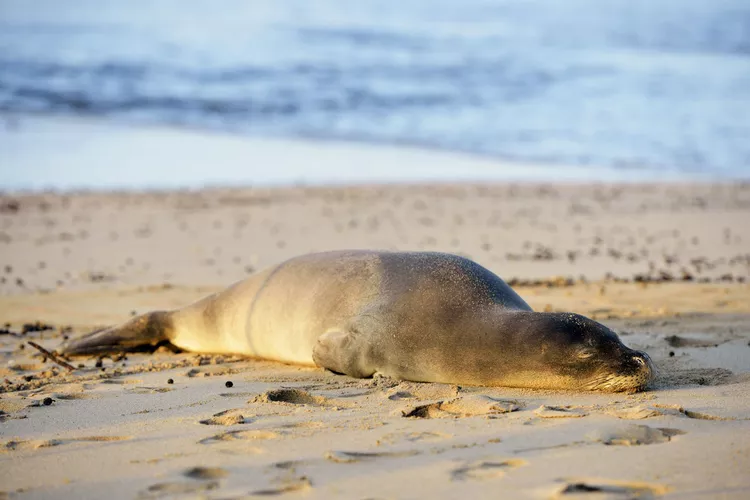Summary of Hawaiian Monk Seals
Introduction to Hawaiian Monk Seals
If you are very lucky when you’re in Hawaii, you may see a Hawaiian monk seal.
The Hawaiian monk seal is an endangered species, with a current population estimated to be only about 1,200. It was officially designated as an endangered species on November 23, 1976, and is now protected by the Endangered Species Act and the Marine Mammal Protection Act.
It is crucial to understand that it is illegal to kill, capture, or harass a Hawaiian monk seal. Consequently, when a monk seal is found on a beach in Hawaii, lifeguards or other officials secure the area with police tape.
The ancient Hawaiians referred to the monk seal as ‘Ilio holo I ka uaua, which translates to “dog that runs in rough water.” This name makes sense considering they had never encountered a seal before.
The U.S. Fish and Wildlife Service provides excellent information about Hawaiian Monk Seals:
“An adult monk seal is usually dark gray or brown with a light gray or yellow belly. Adults can weigh anywhere from 375 to 500 pounds; adult females are generally larger than males. Pups are jet black and usually weigh 25 to 30 pounds at birth, growing to 132 to 198 pounds within five to six weeks. The monk seal’s common name is derived from its folds of skin that resemble a monk’s hood and because it spends most of its time alone or in very small groups. They spend the majority of their time in the ocean but prefer to rest on sandy beaches, often using beach vegetation as shelter from wind and rain. Monk seals are expert swimmers and divers; one seal was recorded diving to depths ranging from 66 to 96 fathoms (396 to 576 feet). On average, a monk seal dives 51.2 times per day. The lifespan of the Hawaiian monk seal is between 25-30 years.”
Where You Can See Them
:max_bytes(150000):strip_icc():format(webp)/gettyimages-520524448-57c99c025f9b5829f4ddcd97.jpg)
For many years, the most likely places to see a Hawaiian monk seal were on the island of Kauai, the island closest to their principal feeding grounds in the Northwestern Hawaiian Islands (from Nihoa Island to Kure Atoll in the Papahānaumokuākea Marine National Monument). They are frequently spotted resting on Poipu Beach and the small beaches along the Na Pali Coast.
However, in recent years, Hawaiian monk seals have been sighted on all the main Hawaiian islands. For instance, in May 2009, a Hawaiian monk seal named Kermit spent an entire week basking on the sand at Queen’s Beach in Waikiki. His presence near popular hotels and surf spots quickly turned his location into a favored stop for beach-goers.
So, what should visitors know when they encounter a Hawaiian monk seal on the beach? The Waikiki Improvement Association provides valuable answers to some frequently asked questions about Hawaiian monk seals.
Frequently Asked Questions
:max_bytes(150000):strip_icc():format(webp)/gettyimages-486369805-57c99c4b5f9b5829f4ddd47e.jpg)
Here are some frequently asked questions:
Are They Dead on the Beach?
Probably not. Monk seals frequently “haul out” on beaches or rocky shorelines to take a break from eating and swimming or sometimes to nurse their pups.
What Do Monk Seals Eat?
Scientists have found that monk seals consume a variety of prey, including small fish, lobsters, and other crustaceans. These seals eat a considerable amount—an adult male can weigh up to 400 lbs!
Should I Try to Approach or Touch a Monk Seal?
It is advisable not to disturb the seal; monk seals generally do not appreciate close contact. Additionally, it is illegal to kill, capture, or harass the seal in any form under the Endangered Species Act and the Marine Mammal Protection Act. Actions like touching, riding, feeding, or anything else that disrupts the seal’s natural behavior are prohibited.
What Are the Main Threats to Monk Seals?
The primary threats to the Hawaiian monk seal include low juvenile survival rates due to starvation, entanglements in marine debris, predation by sharks, disease outbreaks, and human interactions in the Main Hawaiian Islands. “Human disturbance” is defined in the recovery plan as recreational fishing gear entanglements and mother-pup disturbances.
What Can I Do?
- Report all strandings and entanglements to the monk seal hotline: (888) 256-9840
- Report seal sightings: (808) 220-7802
- Share what you learn about these animals and how to protect them.
- Volunteer with NOAA’s Monk Seal Response Program.




